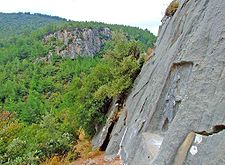- Arzawa
-
 The inscription of the Karabel rock-carved prince-warrior monument in Mount Nif was read as attributing it to "Tarkasnawa, King of Mira", a part of the Kingdom of Arzawa.
The inscription of the Karabel rock-carved prince-warrior monument in Mount Nif was read as attributing it to "Tarkasnawa, King of Mira", a part of the Kingdom of Arzawa.
Arzawa in the second half of the second millennium BC (roughly from late 15th century until the beginning of the 12th century) was the name of a region and a political entity (a "kingdom" or a federation of local powers) in Western Anatolia, the core area of which was centered on the Hermos (Gediz) and Maeander river valleys, corresponding with the Late Bronze Age kingdoms of the Seha River Land and Mira-Kuwaliya.[1] A central part of Arzawa was later to become known as Lydia.
Arzawa was the western neighbor, sometimes drt a rival and sometimes a vassal of the Middle and New Hittite Kingdoms. It was also possibly associated with the much more obscure Assuwa league generally located to its north - it probably bordered it, and may even be an alternative term for it (at least during some periods).
Contents
The kingdom
According to Hittite sources, the capital of the Kingdom of Arzawa was Apasa (or Abasa), corresponding with later Greek Ephesus.[2][3]
The languages spoken in Arzawa during the Bronze Age and early Iron Age cannot be directly determined due to the paucity of indigenous written sources. The current consensus among scholars is that the linguistic identity of Arzawa was predominantly Luwian, based, inter alia, on the replacement of the designation Luwiya with Arzawa in a corrupt passage of a New Hittite copy of the Laws, which appears to reflect a change in the name of the region.[4] However, one scholar has recently argued that Luwiya and Arzawa were two separate entities, because Luwiya is mentioned in the Hittite Laws as a part of the Hittite Old Kingdom, whereas Arzawa was independent from the Hittites during this period. He also argued that there was no significant Luwian population in Arzawa, but instead that it was predominantly inhabited by speakers of Proto-Lydian and Proto-Carian.[5]
The zenith of the kingdom was during the 15th and 14th centuries BC. The Hittites were then weakened, and Arzawa was an ally of Egypt. This alliance is recorded in the correspondence between the Arzawan ruler Tarhundaradu and the Pharaoh Amenophis III called Arzawa letters, part of the archive of the Amarna letters (Nr.31 and 32), having played a substantial role in the decipherment of the Hittite language in which they were written. The Hittite kings Suppiluliuma I and Mursili II, however, finally managed to defeat Arzawa around 1300 BC, and split it into vassal kingdoms. These were called;
- Kingdom of Mira,
- Hapalla (transcriptions vary),
- "Land of the River Seha" (present-day Gediz or Bakırçay rivers or both) and,
- Wilusa (probably Ilion (Troy)).
These kingdoms, usually termed simply as "lands" in Hittite registers, could have formed part of the Arzawa complex already during the existence of Arzawa kingdom.[6]
Known western Anatolian late-Bronze Age regions and/or political entities which, to date, have not been cited as having been part of the Arzawa complex are;
- Land of Masa (or "Masha"),
- Karkiya, (associable with Iron Age "Caria")
- Lukka lands, (associable with Iron Age "Lycia")
After the collapse of the Hittite Empire from the 12th century, while Neo-Hittite states partially pursued Hittite history in southern Anatolia and Syria, the chain seems to have broken as far as Arzawa lands in western Anatolia were concerned and these could have pursued their own cultural path until unification came with the emergence of Lydia as a state under the Mermnad dynasty in the 7th century BC.
There has been evidence from a British expedition in 1954 to Beycesultan in inner western Anatolia which suggests that the local king had central heating in his home. Nothing more was heard from this invention until Gaius Sergius Orata reinvented it in Ancient Rome around 80 BCE.[7]
Kings of Arzawa in the 14th century
- Kupanta-Kurunta
- Madduwatta of Zippasla (conquered Arzawa, may or may not have been king of Arzawa)
- Tarhundaradu
- Anzapahhadu
- Uhhazidi or Uhha-Ziti - defeated by Mursili II around 1320 BCE
See also
- History of the Hittites
- Assuwa
- Lukka
- Lydia
Notes
- ^ Hawkins 1998.
- ^ J. David Hawkins (2009). Article: "The Arzawa letters in recent perspective, p.76". British Museum. http://www.britishmuseum.org/pdf/Hawkins.pdf Article:.
- ^ Hawkins 1998.
- ^ See Melchert 2003; Hawkins 1998; Singer 2005; Hawkins 2009.
- ^ Yakubovich 2010, pp. 107-11
- ^ Trevor Bryce (2005). The Kingdom of the Hittites ISBN 978-019928132-9 ISBN10 0199281327. Oxford University Press.
- ^ Camp, L. Sprague De. The Ancient Engineers. Pages 171-172. Garden City: Doubleday & Company, Inc., 1963.
References
- Hawkins, J. D. 1998. “Tarkasnawa King of Mira: ‘Tarkendemos’, Boğazköy Sealings, and Karabel.’ Anatolian Studies 48:1–31.
- Hawkins, J. D. 2009. ‘The Arzawa letters in recent perspective.’ British Museum Studies in Ancient Egypt and Sudan 14:73–83.
- Melchert, H. Craig (ed.) (2003). The Luwians. Leiden: Brill.
- Singer, I. 2005. ‘On Luwians and Hittites.’ Bibliotheca Orientalis 62:430–51. (Review article of Melchert 2003).
- Yakubovich, Ilya. (2010). Sociolinguistics of the Luwian Language. Leiden: Brill.
External links
History of Anatolia 
Ancient kingdoms of Anatolia Before Achaemenid conquest (546 BC) Hatti • Hittites • Wilusa/Troy • Gasgas • Hayasa-Azzi • Arzawa • Kizzuwatna • Millawanda • Lukka • Assuwa league • Urartu • Neo-Hittites • Phrygia • LydiaAfter Partition of Babylon (323 BC)
Wikimedia Foundation. 2010.
